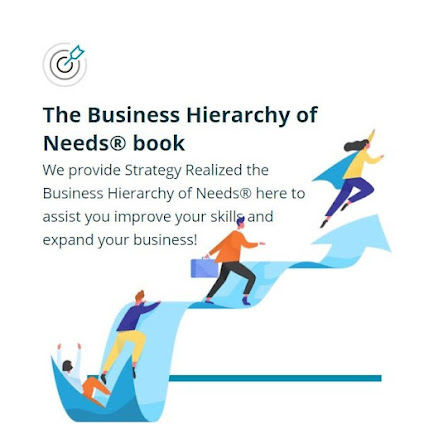The Business Hierarchy of Needs®: How to Prioritize Your Business's Growth
As a business leader, you understand the importance of managing priorities to ensure sustainable growth. However, knowing where to focus your efforts can often feel overwhelming. This is where The Business Hierarchy of Needs® comes into play — a strategic framework that helps you organize your business needs in a way that ensures a solid foundation for long-term success.
If you're wondering how to begin your journey toward prioritizing the right business elements, look no further. This guide will explain how you can leverage The Business Hierarchy of Needs® to structure your business’s growth in the most efficient and impactful way possible.
What is The Business Hierarchy of Needs®?
Much like Maslow’s hierarchy of needs, which applies to human psychology, The Business Hierarchy of Needs® is a framework designed to address the fundamental needs that your business must meet before tackling more complex issues. It takes a structured approach to business growth, ensuring that each foundational need is met before advancing to the next stage.
The hierarchy categorizes business needs from the most basic and essential requirements to more advanced strategic goals. By addressing each need in order, you can ensure that your business is stable and equipped to handle the challenges of growth.
Step 1: Foundation – Stability and Security
The first step in prioritizing your business’s growth is to ensure you have a stable and secure foundation. This is where your basic operational systems, financial health, and legal compliance come into play. Without a solid foundation, your business cannot move forward sustainably. You need to:
- Build strong financial systems: Ensure that your cash flow is positive, and establish proper budgeting and forecasting practices.
- Secure legal compliance: Make sure your business is operating within legal parameters, whether that involves registering your business, obtaining the right permits, or understanding tax obligations.
- Establish clear operational processes: Define efficient workflows for day-to-day operations to minimize mistakes and increase productivity.
Once you’ve secured the stability of your business, you can move to the next level of needs.
Step 2: Internal Alignment – Organizational Efficiency
After establishing a stable foundation, the next critical need is internal alignment. This is the phase where you build a cohesive organizational structure that enables everyone to work toward common goals. Internal alignment involves:
- Streamlining communication: Ensure open lines of communication across all levels of your organization. This fosters collaboration and prevents misunderstandings.
- Establishing leadership and team roles: Define roles clearly within your organization, creating a structure that maximizes strengths and enhances performance.
- Optimizing internal processes: Continuously improve business processes through feedback, analysis, and technology adoption to increase efficiency and reduce waste.
When internal alignment is achieved, your team will be equipped to drive the business toward achieving its broader goals.
Step 3: Customer Focus – Meeting Market Demands
At this stage, your business needs to shift focus toward the external world — your customers. By understanding and meeting market demands, you can ensure growth and profitability. In this stage, the focus is on:
- Developing products/services that meet customer needs: Conduct market research to understand what your customers truly want and tailor your products or services accordingly.
- Building a customer-centric culture: Train your team to prioritize customer satisfaction, from providing excellent service to creating meaningful experiences for clients.
- Leveraging customer feedback: Regularly collect customer feedback to improve and evolve your offerings, ensuring they remain relevant in a competitive market.
Focusing on customer needs is essential for long-term survival and growth in any industry.
Step 4: Strategic Positioning – Growing Your Market Presence
Once you've solidified your internal operations and established customer loyalty, it's time to focus on strategic positioning. In this phase, your goal is to establish a strong presence in the market and build competitive advantages. Key components include:
- Branding and marketing: Position your brand as an industry leader by creating a clear, compelling value proposition and using targeted marketing strategies to reach your ideal customers.
- Expanding your market: Seek new opportunities for expansion, whether that’s reaching new geographic areas, targeting new demographics, or diversifying your product offerings.
- Building partnerships: Foster strategic partnerships with other businesses that align with your goals and can help you reach new customer bases.
Strategic positioning is where you begin to solidify your business’s competitive edge, ensuring that you stand out in a crowded marketplace.
Step 5: Innovation – Scaling for the Future
With a strong foundation, aligned teams, satisfied customers, and a clear market presence, you are now ready for the final stage of growth: innovation. Scaling your business through innovation allows you to remain adaptable in a constantly changing environment. This includes:
- Adopting new technologies: Keep an eye on emerging technologies that can streamline operations, enhance customer experiences, or create new revenue streams.
- Fostering a culture of innovation: Encourage your team to contribute ideas and create a work environment where creativity and new ideas are valued.
- Continuous improvement: Regularly assess and refine your business model to ensure it is agile and can quickly adapt to changing market conditions.
Innovation is key to staying ahead of the curve and maintaining relevance in your industry.
Conclusion
The Business Hierarchy of Needs® is a powerful tool that can help you prioritize the essential elements of your business growth. By following this framework, you ensure that your business builds upon a solid foundation and scales effectively in a sustainable way.
If you're ready to take the next step in your business's growth, visit Strategy Realized to learn more about how you can implement this framework in your own organization.
By focusing on the right priorities at the right time, you’ll position your business for lasting success and growth.



Comments
Post a Comment